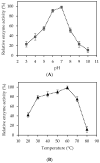Bacillus Cellulase Molecular Cloning, Expression, and Surface Display on the Outer Membrane of Escherichia coli
- PMID: 29495265
- PMCID: PMC6017809
- DOI: 10.3390/molecules23020503
Bacillus Cellulase Molecular Cloning, Expression, and Surface Display on the Outer Membrane of Escherichia coli
Abstract
One of the main challenges of using recombinant enzymes is that they are derived from genetically-modified microorganisms commonly located in the intracellular region. The use of these recombinant enzymes for commercial purposes requires the additional processes of cell disruption and purification, which may result in enzyme loss, denaturation, and increased total production cost. In this study, the cellulase gene of Bacillus licheniformis ATCC 14580 was cloned, over-expressed, and surface displayed in recombinant Escherichia coli using an ice-nucleation protein (INP). INP, an outer membrane-bound protein from Pseudomonas syringae, was utilized as an anchor linker, which was cloned with a foreign cellulase gene into the pET21a vector to develop a surface display system on the outer membrane of E. coli. The resulting strain successfully revealed cellulase on the host cell surface. The over-expressed INP-cellulase fusion protein was confirmed via staining assay for determining the extracellular cellulase and Western blotting method for the molecular weight (MW) of cellulase, which was estimated to be around 61.7 kDa. Cell fractionation and localization tests demonstrated that the INP-cellulase fusion protein was mostly present in the supernatant (47.5%) and outer membrane (19.4%), while the wild-type strain intracellularly retained enzymes within cytosol (>61%), indicating that the INP gene directed the cellulase expression on the bacteria cell surface. Further studies of the optimal enzyme activity were observed at 60 °C and pH 7.0, and at least 75% of maximal enzyme activity was preserved at 70 °C.
Keywords: Bacillus licheniformis; Pseudomonas syringae; cellulase; ice nucleation protein; surface anchoring; whole cell catalysis.
Conflict of interest statement
The authors declare no conflict of interest.
Figures



Similar articles
-
Expression of carboxymethylcellulase on the surface of Escherichia coli using Pseudomonas syringae ice nucleation protein.Enzyme Microb Technol. 1998 Apr;22(5):348-54. doi: 10.1016/s0141-0229(97)00224-x. Enzyme Microb Technol. 1998. PMID: 9549104
-
Cloning and expression of β-1, 4-endoglucanase gene from Bacillus subtilis isolated from soil long term irrigated with effluents of paper and pulp mill.Microbiol Res. 2014 Sep-Oct;169(9-10):693-8. doi: 10.1016/j.micres.2014.02.006. Epub 2014 Feb 25. Microbiol Res. 2014. PMID: 24636744
-
Surface display expression of Bacillus licheniformis lipase in Escherichia coli using Lpp'OmpA chimera.J Microbiol. 2014 Oct;52(10):856-62. doi: 10.1007/s12275-014-4217-7. Epub 2014 Aug 27. J Microbiol. 2014. PMID: 25163839
-
Recombinant expression and characterization of a novel endoglucanase from Bacillus subtilis in Escherichia coli.Mol Biol Rep. 2014 May;41(5):3295-302. doi: 10.1007/s11033-014-3192-8. Epub 2014 Feb 4. Mol Biol Rep. 2014. PMID: 24493451
-
Escherichia coli Surface Display: Advances and Applications in Biocatalysis.ACS Synth Biol. 2025 Mar 21;14(3):648-661. doi: 10.1021/acssynbio.4c00793. Epub 2025 Mar 6. ACS Synth Biol. 2025. PMID: 40047247 Review.
Cited by
-
Production, Purification, and Characterization of a Cellulase from Paenibacillus elgii.Polymers (Basel). 2024 Jul 17;16(14):2037. doi: 10.3390/polym16142037. Polymers (Basel). 2024. PMID: 39065354 Free PMC article.
-
De novo genome assembly and comparative annotation reveals metabolic versatility in cellulolytic bacteria from cropland and forest soils.Funct Integr Genomics. 2020 Jan;20(1):89-101. doi: 10.1007/s10142-019-00704-0. Epub 2019 Aug 5. Funct Integr Genomics. 2020. PMID: 31378834
-
Decorating the surface of Escherichia coli with bacterial lipoproteins: a comparative analysis of different display systems.Microb Cell Fact. 2021 Feb 2;20(1):33. doi: 10.1186/s12934-021-01528-z. Microb Cell Fact. 2021. PMID: 33531008 Free PMC article.
-
In vivo evaluation of the anti-obesity effects of combinations of Monascus pigment derivatives.RSC Adv. 2020 Jan 8;10(3):1456-1462. doi: 10.1039/c9ra08036h. eCollection 2020 Jan 7. RSC Adv. 2020. PMID: 35494723 Free PMC article.
-
Soil-derived cellulose-degrading bacteria: screening, identification, the optimization of fermentation conditions, and their whole genome sequencing.Front Microbiol. 2024 Jul 10;15:1409697. doi: 10.3389/fmicb.2024.1409697. eCollection 2024. Front Microbiol. 2024. PMID: 39050626 Free PMC article.
References
-
- Feng Y., Zhang M., Mujumdar A.S., Gao Z. Recent research process of fermented plant extract: A review. Trends Food Sci. Technol. 2017;65:40–48. doi: 10.1016/j.tifs.2017.04.006. - DOI
-
- Hasunuma T., Okazaki F., Okai N., Hara K.Y., Ishii J., Kondo A. A review of enzymes and microbes for lignocellulosic biorefinery and the possibility of their application to consolidated bioprocessing technology. Bioresour. Technol. 2013;135:513–522. doi: 10.1016/j.biortech.2012.10.047. - DOI - PubMed
MeSH terms
Substances
LinkOut - more resources
Full Text Sources
Other Literature Sources
Molecular Biology Databases

